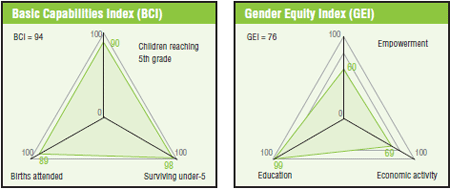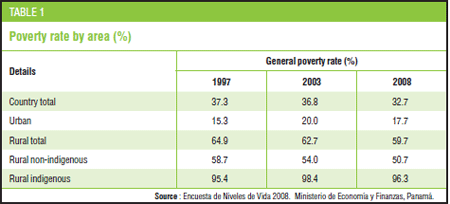Economic growth is not enough
Centro de la Mujer Panameña
Cecilia Moreno Rojas
Panama has enjoyed economic growth in recent years, but this has not led to people being empowered or freed to live decent and fulfilling lives. Nor has it resulted in effective policies to reduce poverty or preserve and protect the environment. Since 2009 the Government has made policy mistakes that have damaged governability, disturbed the populace and generated a climate of tension in the country. To achieve a sustainable development model, the Government will have to design and implement better policies and increase social investment so as to tackle the alarming levels of inequality in the country.
 |
Panama’s economy has grown strongly in recent years, and in 2010 this trend reached a peak of 7% annual growth.[1] The driving force has been investment in public works, widening the Panama Canal and expanding services. This progress was duly noted by the World Bank, the International Monetary Fund and the United Nations, all of which report that the country has the highest per capita income in Central America. In 2009 Panama’s GDP was USD 24,711,000 million, and its per capita GDP was USD 6,570 while the Economic Commission on Latin America and the Caribbean (ECLAC) reported that Panama is the region’s largest exporter and importer. [2]
However, this healthy growth trend contrasts sharply with a social panorama of poverty, unequal income distribution and gender inequity. There are still enormous problems of social inequality to be overcome. Income distribution gaps are very wide, especially when they are analysed by type of region, ethnicity and gender. These disparities can be seen in the country’s Gini coefficient, which data from 2005[3] show to be approximately 55, a clear indication that inequality is a serious problem.
 |
Panama’s growth is based on unsustainable development models that focus on economic indicators and ignore the most pressing social and environmental problems. This is a complex challenge for civil society organizations, above all because the style of government imposed by President Ricardo Martinelli is markedly autocratic and far to the political right.
Further, there is a recurrent pattern that every five years the country has to be reinvented. The slate is wiped clean, and public policies start again from scratch. For example, in 2004 and 2005 the Administrator of the National Environment Authority (ANAM), in cooperation with a team of inter-institutional specialists, designed seven public policies for the priority areas of water resources; climate change; cleaner production; supervision, control and monitoring of solid waste; environmental information and the decentralization of environmental management. These policies were promulgated in 2007, but they were never implemented because a new Government came to power in July 2009.
At the present time the country does not have an environmental policy; the new ANAM authorities who came to power in 2009 completely ignored the progress that had been made in this field. What is more and against all expectations, a year and a half after coming to power President Martinelli - with the backing of his Cabinet and a majority in the National Assembly - made a series of changes to the Environment Law that eliminated the requirement that enterprises perform environmental impact studies.[4] These changes also opened the door for members of the Government to invest in and promote public works or mining projects without having to hold any public consultations. The ANAN administration said nothing about this change and remained passively in the background while the process went on. Environmental groups severely criticized its stance, denouncing the ANAM as “weak” and lacking “a loud clear voice” to guide the country’s environment policy.[5]
Union groups protested changes to the labour law that restricted their right to strike and other social organizations protested similar legal maneuvres that constituted a violation of human rights. The population at large rejected the new legislation, causing a chain reaction among civil society organizations and above all among environmental organizations. For three months Panama convulsed with public protests and demonstrations in a range of different sectors. The changes were finally repealed in October 2010. “[W]orkers’ right to strike and union fees were re-established; the [Martinelli] policies could no longer go ahead with impunity; and the environmentalists were able to reimpose the obligation to carry out environment impact studies.”[6]
The deterioration of natural resources
Another serious obstacle to sustainable development in Panama is the increasing deterioration of the country’s biological corridors and a large part of its natural resources due to indiscriminate exploitation of its forests, extensive livestock rearing and environmental pollution caused by the open-pit mining techniques used by transnational enterprises. When these trends are added to the effects of climate change there could be serious repercussions not only on the environment but on people’s health and well-being.
Panama is suffering from severe soil erosion and deterioration, which is gradually spreading to nearly all of its valleys, land and water resources, leading towards desertification and the loss of productive capacity. Large swathes of the country’s forests have already been destroyed, mainly as a result of agriculture.[7]
According to ANAM’s Environment Information System figures, desertification is taking hold at an alarming rate. In 1970 some 70% of the country was under forest cover but by 2011 this had been reduced to around 35%.The last in-depth report on the situation dates from 2000, and it shows that forest coverage in 1992 amounted to 49% of the country, but by 2000 (in just eight years) it had shrunk to 45%.[8]
Water pollution
Environmental protection organizations have reported that important sources of fresh water near the Panama Canal valley have been polluted by the operations of two gold and copper mining projects in the Petaquilla and Molejones area, 100 km from the capital. These groups monitored the situation, and water and sediment from sources near the mining area were analysed. The tests showed that the water has high levels of suspended solids and excessive turbidity. Little by little the pollution is negatively affecting the natural environment in very serious ways.[9] These organizations have repeatedly warned the authorities that the levels of substances in rivers potentially dangerous to the environment and to people’s health may increase. But instead of paying due attention to this threat, the Government has persisted in its policy of promoting activities that are not sustainable and cause pollution – mining is a prime example – as a strategy for economic development. In fact, the Government has made a series of changes to the mining laws to make it easier for various transnational mining enterprises to operate in the country.[10]
Access to potable water
According to a UN report on Panama’s progress towards the Millennium Development Goals (MDGs), large sectors of the population do not have access to potable water. This problem is most acute in rural areas, indigenous communities and some marginalized urban areas on the outskirts of cities where most of the people are of mixed race or of African descent. The situation as regards access to improved sewage facilities is similar, and rural and indigenous population groups suffer the consequences of this unequal distribution of services.[11]
The MDG report also states that the precarious settlement populations are far from being able to satisfy their basic needs. Most are families in the grip of poverty and unemployment and have no other alternative in their search for a place to live. The report recognizes that there is a close connection between illiteracy and poverty that subsequently translates into other inequalities including limited access to health services and decent housing, gender inequality, reduced political participation and a lack of protection for the environment.[12]
According to a Levels of Life Survey (ENV) that was carried out in Panama in 2003, some 36.8% of the population were living in poverty, defined as an income of less than USD 100 a month, and 16.6% were living in extreme poverty. In 2008 a similar study found there had been a slight improvement with poverty falling to 32.7% and extreme poverty to 14.4%.[13]
In urban areas where migrants from the countryside are swelling the population without government planning for urban growth, the overall poverty rate is 20%, and 4.4% of the people are in extreme poverty. In non-indigenous rural areas more than half the population (54%) is still living in poverty, and over one in five of these people (22%) are in extreme poverty. In indigenous rural areas the situation is extremely critical as nearly the whole population (98.4%) is in poverty, and the extreme poverty rate is 90%.[14]
Gender inequality and poverty
If Panama is to overcome poverty and social exclusion, it has to tackle problems of social and gender inequality. Currently, women and children are more vulnerable to poverty than are men and have fewer opportunities to escape it. Poverty in general is high, but this is even more worrying when we consider its scope and impact by age brackets or ethnicity.
Gender inequalities can be seen most clearly in the labour market. According to official figures, women’s earnings were only 57% of men’s earnings in 2009. Although women make up half the population a large percentage of women of productive age (51.7%) are not involved in the formal workforce, which is a major factor in the country’s poverty profile. Women are still the most vulnerable group in the labour market, and most of the work they do is not paid at all. According to the 2009 household survey, some 80.9% of the economically active male population had jobs, but only 48.3% of the economically active female population was gainfully employed. In 2009, the unemployment rate among women was 9.27%, which contrasts sharply to the 5.25% rate among men.[15]
Women’s situation is better in the education field. Statistics show they are an average of two percentage points ahead of men in access to schooling. Girls of the younger generations have greater access to education than their mothers and grandmothers had, but in some indigenous areas the schooling indicator for women is lower than that for men.[16]
Conclusion
Panama’s approach to economic development ignores sustainability and has led to a degradation of its environmental resources while having only minimal impact in improving the lives and well-being of the majority of its people. Deforestation, desertification, water pollution, accessibility to potable water, and inadequate sewage facilities threaten the environment and the very health of the Panamanian people. Especially affected are migrants from the countryside in overcrowded settlements in towns and cities and the rural population, notably those in indigenous communities, which suffer from severe and sometimes extreme poverty. Women, particularly, have been hard-hit by economic development models that look first to benefit wealthy national elites and their international partners and investors.
[2] World Bank, Panama, <datos.bancomundial.org/pais/panama>.
[3] Trading Economics, GINI index in Panama, <www.tradingeconomics.com/panama/gini-index-wb-data.html>.
[4] See: <www.asamblea.gob.pa/actualidad/proyectos/2010/2010_P_227.pdf >.
[5] See: <www.expresiones7.net/Exp2.0/Entrevista.htm>.
[6] See: <www.rnw.nl>.
[7] Ibid.
[8] L. Vidal Berrío, “Cobertura boscosa se reduce 50%,” Capital, (6 June 2011), <www.capital.com.pa/?p=4117>.
[9] Teorema Ambiental, “Advierten sobre el riesgo de contaminación de agua en Panamá.”, Teorema Ambental, Revista Técnico Ambiental, <www.teorema.com.mx>.
[10] In a statement to the media the Minister of Trade said, “Adjustment (to the Mining Code) is needed as one of the countries interested in investing in the Donoso copper mine project in the province of Colón is the Republic of Korea, since numeral 1, article 4 of Decree Law 23, prohibits the granting of mining concessions to foreign governments or countries.” In La Estrella.com.pa,(1 September 2010), <www.laestrella.com.pa/mensual/2010/09/01/contenido/273813.asp>.
[11] See: <www.onu.org.pa/objetivos-desarrollo-milenio-ODM/garantizar-sostenibilidad-ambiental>.
[12] Ibid.
[13]Ministerio de Economía y Finanzas de Panama, Encuesta Niveles de Vida, (Panama, Panama City: 2008).
[14] Ibid,,La Pobreza En Panamá, Encuesta de Niveles de Vida – 2003 Principales. Resultados, Edición Revisada, (2005).
[15] MInisterio de Controlaria de Panama, Encuesta Continua de Hogares 2009, <www.contraloria.gob.pa/inec/Publicaciones/05-03-31/441-02.pdf>.
[16] Atlas de Desarrollo Humano y Objetivos del Milenio, (2010).


